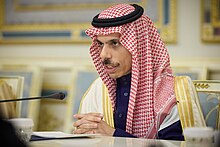Ministry of Foreign Affairs (Saudi Arabia)
| وزارة الخارجية السعودية | |
 Seal of the Ministry of Foreign Affairs of Saudi Arabia | |
 Faisal bin Farhan Al Saud,the current Minister of Foreign Affairs since 2019 | |
| Agency overview | |
|---|---|
| Formed | 1930 |
| Preceding agency |
|
| Jurisdiction | Government of Saudi Arabia |
| Headquarters | Nasseriya Street,Riyadh |
| Agency executive |
|
| Child agency |
|
| Website | Official English Site |
 |
|---|
|
|
| Basic Law |
|
|
TheMinistry of Foreign Affairs(MoFA;Arabic:وزارة الخارجيةWizārat al-Khārijīyah) is the ministry responsible for handling theKingdom of Saudi Arabia'sexternal relations.The ministry oversees "political, cultural and financial international relations" and monitors the Kingdom's diplomatic relations.[1]It was created in 1930 by a royal decree issued byKing Abdulaziz Al Saud,being the first ministerial body created by the King.[2]
History
[edit]While consolidating the newly formedKingdom of Nejd and Hejaz,King Abdulaziz, established foreign diplomatic relations by sending representatives and receiving delegations from various states. In 1926, he established the directorate general for foreign affairs inMecca.[2]A branch of the directorate was also opened inJeddah.[3]The first director general of foreign affairs wasAbdullah Beg Al Damluji,who was also ruler of Hejaz at that time.[4]
In 1930, a royal decree was issued to elevate the directorate general to the ministry of foreign affairs.[5]King Abdulaziz appointed his son,Prince Faisal,as the first foreign minister.[6]The Kingdom of Saudi Arabia was formallyestablishedby King Abdulaziz in 1932.
Initially the ministry was made up of five departments, namely the private office and the departments of oriental affairs, administrative affairs, political affairs and consular affairs.[2]The ministry began establishing diplomatic missions abroad. The first one was opened inCairoin 1926 followed by another inLondon1930.[2]The number of missions increased from five in 1936 to 18 in 1951 and expanded further after that.
Aside from a brief interjection, Prince Faisal continued to serve even after he succeeded the throne asKing.After his assassination in 1975, Faisal was succeeded as foreign minister by his son,Prince Saud.[6]Saud was the longest-serving foreign minister of any country in current political times,[7]The ministry launched a magazine,The Diplomat,in 2007.[8]
It was rumored in 2010 that the next foreign minister would bePrince Turki Al Faisal,Saud's younger brother, after Saud retired, which however did not occur.[9]
Senior officials
[edit]The senior officials in the ministry are as follows:
| Official | Rank |
|---|---|
| Faisal bin Farhan Al Saud | Minister of Foreign Affairs |
| Waleed A. Elkhereiji | Deputy Minister of Foreign Affairs |
| Sara Al Sayed | Deputy Minister of Foreign Affairs for Public Diplomacy |
| Adel al-Jubeir | Minister of State for Foreign Affairs |
List of ministers
[edit]Ministers of Foreign Affairs
[edit]The following is the list of foreign ministers since its foundation:[6]
| No. | Image | Name | Took office | Left office | King |
|---|---|---|---|---|---|
| 1 | 
|
Faisal bin Abdulaziz Al Saud | 19 December 1930 | 22 December 1960 | Abdulaziz(1932–1953)
Saud(1953–1964) |
| 2 | 
|
Ibrahim bin Abdullah Al Suwaiyel | 22 December 1960 | 16 March 1962 | Saud(1953–1964) |
| 3 | 
|
Faisal bin Abdulaziz Al Saud | 16 March 1962 | 25 March 1975 | Saud(1953–1964)
Himself (1964–1975) |
| 4 | 
|
Saud bin Faisal Al Saud | 13 October 1975 | 29 April 2015 | Khalid(1975–1982) |
| 5 | 
|
Adel al-Jubeir | 29 April 2015 | 27 December 2018 | Salman(2015–present) |
| 6 | 
|
Ibrahim Abdulaziz Al-Assaf | 27 December 2018 | 23 October 2019 | Salman(2015–present) |
| 7 | 
|
Faisal bin Farhan Al Saud | 23 October 2019 | Present | Salman(2015–present) |
Ministers of State for Foreign Affairs
[edit]The ministers of state for foreign affairs served are as follows:[4]
- Omar Al Saqqaf(1968–November 1974)
- Mohammad Ibrahim Massoud (November 1974–March 1975)[10]
- Saud bin Faisal Al Saud(March 1975–October 1975)[10]
- Nizar Madani(2005–2018)
- Adel al-Jubeir(2018–Present)
Building
[edit]The building of the ministry is inRiyadhand was designed byHenning Larsen.[11]It blends both vernacular and monumental styles ofIslamic architecture.[12]Larsen received theAga Khan Award for Architecturein 1989 for his work on the building.[12][13]
Built in 1984, building consists of meeting, conference and prayer rooms, a library and a banquet hall.[12]Externally, the building appears as a fortress that was carved out of a single piece of stone.[13]
See also
[edit]References
[edit]- ^"Ministry Addresses".Royal Embassy of Saudi Arabia, Washington, DC. Archived fromthe originalon 26 April 2011.Retrieved30 April2011.
- ^abcdMohammad Zaid Al Kahtani (December 2004).The Foreign Policy of King Abdulaziz(PDF)(PhD thesis). University of Leeds.Retrieved21 July2013.
- ^Mansour Alsharidah (July 2020).Merchants without Borders: Qusman Traders in the Arabian Gulf and Indian Ocean, c. 1850-1950(PhD)(Thesis). University of Arkansas, Fayetteville. p. 227.Retrieved13 March2021.
- ^ab"حول الوزارة"(in Arabic). Ministry of Foreign Affairs (Saudi Arabia). 5 May 2005.Retrieved30 April2011.
- ^Steffen Hertog (2007)."Shaping the Saudi state: Human agency's shifting role in the rentier state formation"(PDF).International Journal of Middle East Studies.39(4): 539–563.doi:10.1017/S0020743807071073.S2CID145139112.Retrieved17 April2012.
- ^abc"Brief History".Ministry of Foreign Affairs (Saudi Arabia). 5 May 2005.Retrieved30 April2011.
- ^Michael Slackman (9 December 2009)."A Legacy of Regret for a Saudi Diplomat".The New York Times.Retrieved6 May2011.
- ^"Diplomat".Arab Media Company.Retrieved21 May2012.
- ^Simon Henderson (22 October 2010)."Foreign Policy: A Prince's Mysterious Disappearance".NPR.Retrieved30 April2011.
- ^ab"New Saudi Arabia King Picks Deputy Premiers".Sarasota Herald-Tribune.United Press International.30 March 1975.Retrieved6 November2022.
- ^Sama AlMalik (2017).Improving the city image of Riyadh. Through storefront and street signage redesign(PDF)(MA thesis). University of Barcelona.Retrieved7 October2020.
- ^abc"Ministry of Foreign Affairs".ArchNet.Archived fromthe originalon 19 June 2010.Retrieved30 April2011.
- ^abPaul Rivas."Islamic architecture personified by Ministry of Foreign Affairs in Riyadh".The Saudi Gazette.Archived fromthe originalon 13 September 2012.Retrieved30 April2011.

